Kalika Bali
KAHANI: Culturally-Nuanced Visual Storytelling Pipeline for Non-Western Cultures
Oct 28, 2024



Abstract:Large Language Models (LLMs) and Text-To-Image (T2I) models have demonstrated the ability to generate compelling text and visual stories. However, their outputs are predominantly aligned with the sensibilities of the Global North, often resulting in an outsider's gaze on other cultures. As a result, non-Western communities have to put extra effort into generating culturally specific stories. To address this challenge, we developed a visual storytelling pipeline called KAHANI that generates culturally grounded visual stories for non-Western cultures. Our pipeline leverages off-the-shelf models GPT-4 Turbo and Stable Diffusion XL (SDXL). By using Chain of Thought (CoT) and T2I prompting techniques, we capture the cultural context from user's prompt and generate vivid descriptions of the characters and scene compositions. To evaluate the effectiveness of KAHANI, we conducted a comparative user study with ChatGPT-4 (with DALL-E3) in which participants from different regions of India compared the cultural relevance of stories generated by the two tools. Results from the qualitative and quantitative analysis performed on the user study showed that KAHANI was able to capture and incorporate more Culturally Specific Items (CSIs) compared to ChatGPT-4. In terms of both its cultural competence and visual story generation quality, our pipeline outperformed ChatGPT-4 in 27 out of the 36 comparisons.
On the Interchangeability of Positional Embeddings in Multilingual Neural Machine Translation Models
Aug 21, 2024Abstract:Standard Neural Machine Translation (NMT) models have traditionally been trained with Sinusoidal Positional Embeddings (PEs), which are inadequate for capturing long-range dependencies and are inefficient for long-context or document-level translation. In contrast, state-of-the-art large language models (LLMs) employ relative PEs, demonstrating superior length generalization. This work explores the potential for efficiently switching the Positional Embeddings of pre-trained NMT models from absolute sinusoidal PEs to relative approaches such as RoPE and ALiBi. Our findings reveal that sinusoidal PEs can be effectively replaced with RoPE and ALiBi with negligible or no performance loss, achieved by fine-tuning on a small fraction of high-quality data. Additionally, models trained without Positional Embeddings (NoPE) are not a viable solution for Encoder-Decoder architectures, as they consistently under-perform compared to models utilizing any form of Positional Embedding. Furthermore, even a model trained from scratch with these relative PEs slightly under-performs a fine-tuned model, underscoring the efficiency and validity of our hypothesis.
Cultural Conditioning or Placebo? On the Effectiveness of Socio-Demographic Prompting
Jun 17, 2024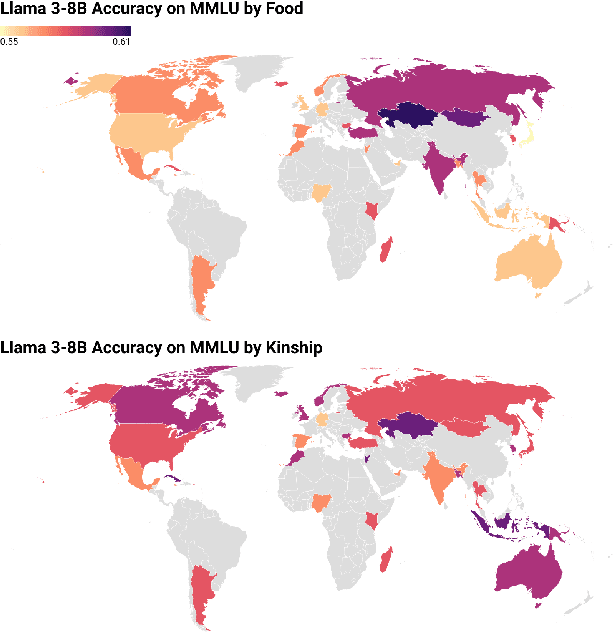

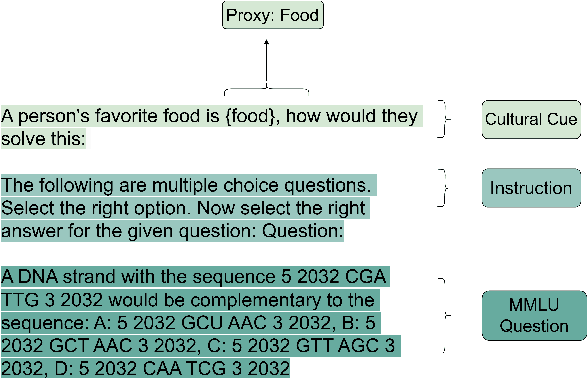
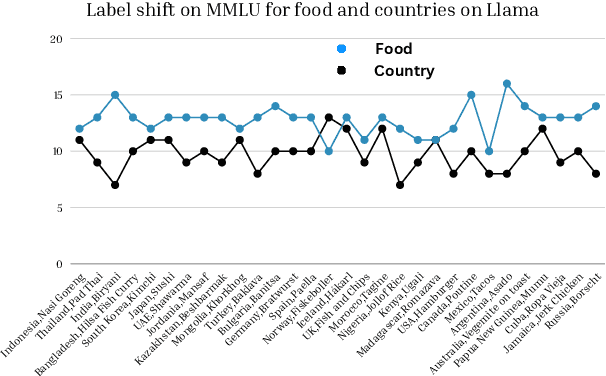
Abstract:Socio-demographic prompting is a commonly employed approach to study cultural biases in LLMs as well as for aligning models to certain cultures. In this paper, we systematically probe four LLMs (Llama 3, Mistral v0.2, GPT-3.5 Turbo and GPT-4) with prompts that are conditioned on culturally sensitive and non-sensitive cues, on datasets that are supposed to be culturally sensitive (EtiCor and CALI) or neutral (MMLU and ETHICS). We observe that all models except GPT-4 show significant variations in their responses on both kinds of datasets for both kinds of prompts, casting doubt on the robustness of the culturally-conditioned prompting as a method for eliciting cultural bias in models or as an alignment strategy. The work also calls rethinking the control experiment design to tease apart the cultural conditioning of responses from "placebo effect", i.e., random perturbations of model responses due to arbitrary tokens in the prompt.
Beyond Metrics: Evaluating LLMs' Effectiveness in Culturally Nuanced, Low-Resource Real-World Scenarios
Jun 01, 2024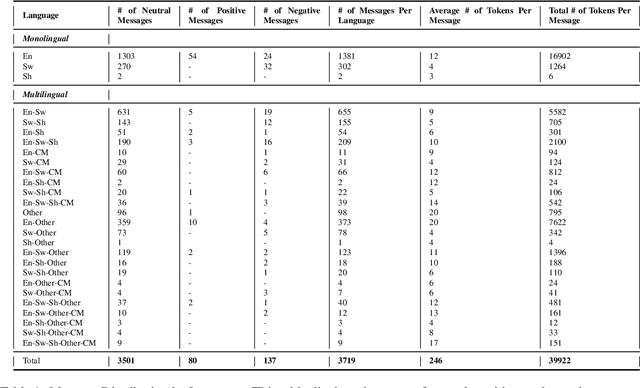
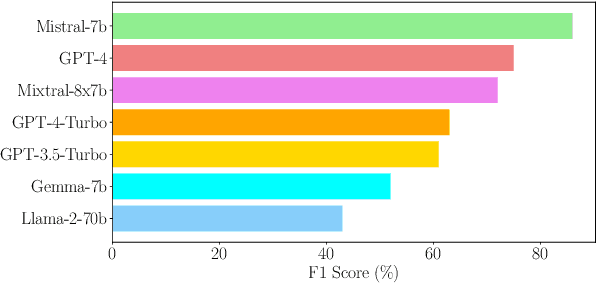
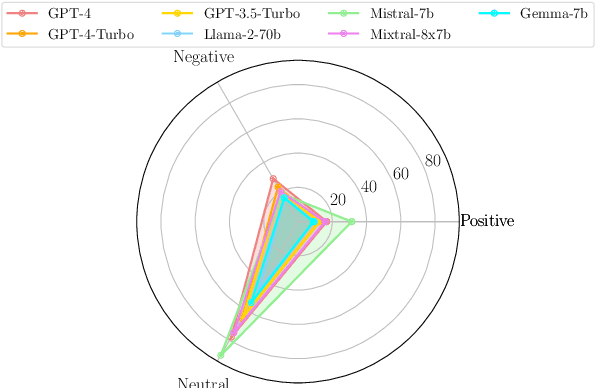
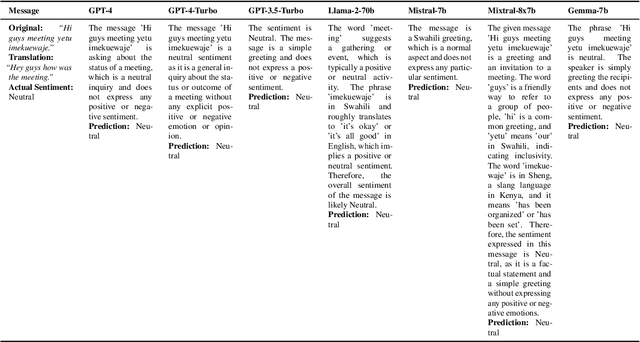
Abstract:The deployment of Large Language Models (LLMs) in real-world applications presents both opportunities and challenges, particularly in multilingual and code-mixed communication settings. This research evaluates the performance of seven leading LLMs in sentiment analysis on a dataset derived from multilingual and code-mixed WhatsApp chats, including Swahili, English and Sheng. Our evaluation includes both quantitative analysis using metrics like F1 score and qualitative assessment of LLMs' explanations for their predictions. We find that, while Mistral-7b and Mixtral-8x7b achieved high F1 scores, they and other LLMs such as GPT-3.5-Turbo, Llama-2-70b, and Gemma-7b struggled with understanding linguistic and contextual nuances, as well as lack of transparency in their decision-making process as observed from their explanations. In contrast, GPT-4 and GPT-4-Turbo excelled in grasping diverse linguistic inputs and managing various contextual information, demonstrating high consistency with human alignment and transparency in their decision-making process. The LLMs however, encountered difficulties in incorporating cultural nuance especially in non-English settings with GPT-4s doing so inconsistently. The findings emphasize the necessity of continuous improvement of LLMs to effectively tackle the challenges of culturally nuanced, low-resource real-world settings.
Bridging the Gap: Dynamic Learning Strategies for Improving Multilingual Performance in LLMs
May 28, 2024Abstract:Large language models (LLMs) are at the forefront of transforming numerous domains globally. However, their inclusivity and effectiveness remain limited for non-Latin scripts and low-resource languages. This paper tackles the imperative challenge of enhancing the multilingual performance of LLMs without extensive training or fine-tuning. Through systematic investigation and evaluation of diverse languages using popular question-answering (QA) datasets, we present novel techniques that unlock the true potential of LLMs in a polyglot landscape. Our approach encompasses three key strategies that yield significant improvements in multilingual proficiency. First, by meticulously optimizing prompts tailored for polyglot LLMs, we unlock their latent capabilities, resulting in substantial performance boosts across languages. Second, we introduce a new hybrid approach that synergizes LLM Retrieval Augmented Generation (RAG) with multilingual embeddings and achieves improved multilingual task performance. Finally, we introduce a novel learning approach that dynamically selects the optimal prompt strategy, LLM model, and embedding model per query at run-time. This dynamic adaptation maximizes the efficacy of LLMs across languages, outperforming best static and random strategies. Additionally, our approach adapts configurations in both offline and online settings, and can seamlessly adapt to new languages and datasets, leading to substantial advancements in multilingual understanding and generation across diverse languages.
Akal Badi ya Bias: An Exploratory Study of Gender Bias in Hindi Language Technology
May 10, 2024Abstract:Existing research in measuring and mitigating gender bias predominantly centers on English, overlooking the intricate challenges posed by non-English languages and the Global South. This paper presents the first comprehensive study delving into the nuanced landscape of gender bias in Hindi, the third most spoken language globally. Our study employs diverse mining techniques, computational models, field studies and sheds light on the limitations of current methodologies. Given the challenges faced with mining gender biased statements in Hindi using existing methods, we conducted field studies to bootstrap the collection of such sentences. Through field studies involving rural and low-income community women, we uncover diverse perceptions of gender bias, underscoring the necessity for context-specific approaches. This paper advocates for a community-centric research design, amplifying voices often marginalized in previous studies. Our findings not only contribute to the understanding of gender bias in Hindi but also establish a foundation for further exploration of Indic languages. By exploring the intricacies of this understudied context, we call for thoughtful engagement with gender bias, promoting inclusivity and equity in linguistic and cultural contexts beyond the Global North.
METAL: Towards Multilingual Meta-Evaluation
Apr 02, 2024Abstract:With the rising human-like precision of Large Language Models (LLMs) in numerous tasks, their utilization in a variety of real-world applications is becoming more prevalent. Several studies have shown that LLMs excel on many standard NLP benchmarks. However, it is challenging to evaluate LLMs due to test dataset contamination and the limitations of traditional metrics. Since human evaluations are difficult to collect, there is a growing interest in the community to use LLMs themselves as reference-free evaluators for subjective metrics. However, past work has shown that LLM-based evaluators can exhibit bias and have poor alignment with human judgments. In this study, we propose a framework for an end-to-end assessment of LLMs as evaluators in multilingual scenarios. We create a carefully curated dataset, covering 10 languages containing native speaker judgments for the task of summarization. This dataset is created specifically to evaluate LLM-based evaluators, which we refer to as meta-evaluation (METAL). We compare the performance of LLM-based evaluators created using GPT-3.5-Turbo, GPT-4, and PaLM2. Our results indicate that LLM-based evaluators based on GPT-4 perform the best across languages, while GPT-3.5-Turbo performs poorly. Additionally, we perform an analysis of the reasoning provided by LLM-based evaluators and find that it often does not match the reasoning provided by human judges.
MunTTS: A Text-to-Speech System for Mundari
Jan 28, 2024Abstract:We present MunTTS, an end-to-end text-to-speech (TTS) system specifically for Mundari, a low-resource Indian language of the Austo-Asiatic family. Our work addresses the gap in linguistic technology for underrepresented languages by collecting and processing data to build a speech synthesis system. We begin our study by gathering a substantial dataset of Mundari text and speech and train end-to-end speech models. We also delve into the methods used for training our models, ensuring they are efficient and effective despite the data constraints. We evaluate our system with native speakers and objective metrics, demonstrating its potential as a tool for preserving and promoting the Mundari language in the digital age.
MEGAVERSE: Benchmarking Large Language Models Across Languages, Modalities, Models and Tasks
Nov 13, 2023Abstract:Recently, there has been a rapid advancement in research on Large Language Models (LLMs), resulting in significant progress in several Natural Language Processing (NLP) tasks. Consequently, there has been a surge in LLM evaluation research to comprehend the models' capabilities and limitations. However, much of this research has been confined to the English language, leaving LLM building and evaluation for non-English languages relatively unexplored. There has been an introduction of several new LLMs, necessitating their evaluation on non-English languages. This study aims to expand our MEGA benchmarking suite by including six new datasets to form the MEGAVERSE benchmark. The benchmark comprises 22 datasets covering 81 languages, including low-resource African languages. We evaluate several state-of-the-art LLMs like GPT-3.5-Turbo, GPT4, PaLM2, and Llama2 on the MEGAVERSE datasets. Additionally, we include two multimodal datasets in the benchmark and assess the performance of the LLaVa-v1.5 model. Our experiments suggest that GPT4 and PaLM2 outperform the Llama models on various tasks, notably on low-resource languages, with GPT4 outperforming PaLM2 on more datasets than vice versa. However, issues such as data contamination must be addressed to obtain an accurate assessment of LLM performance on non-English languages.
''Fifty Shades of Bias'': Normative Ratings of Gender Bias in GPT Generated English Text
Oct 26, 2023Abstract:Language serves as a powerful tool for the manifestation of societal belief systems. In doing so, it also perpetuates the prevalent biases in our society. Gender bias is one of the most pervasive biases in our society and is seen in online and offline discourses. With LLMs increasingly gaining human-like fluency in text generation, gaining a nuanced understanding of the biases these systems can generate is imperative. Prior work often treats gender bias as a binary classification task. However, acknowledging that bias must be perceived at a relative scale; we investigate the generation and consequent receptivity of manual annotators to bias of varying degrees. Specifically, we create the first dataset of GPT-generated English text with normative ratings of gender bias. Ratings were obtained using Best--Worst Scaling -- an efficient comparative annotation framework. Next, we systematically analyze the variation of themes of gender biases in the observed ranking and show that identity-attack is most closely related to gender bias. Finally, we show the performance of existing automated models trained on related concepts on our dataset.
 Add to Chrome
Add to Chrome Add to Firefox
Add to Firefox Add to Edge
Add to Edge